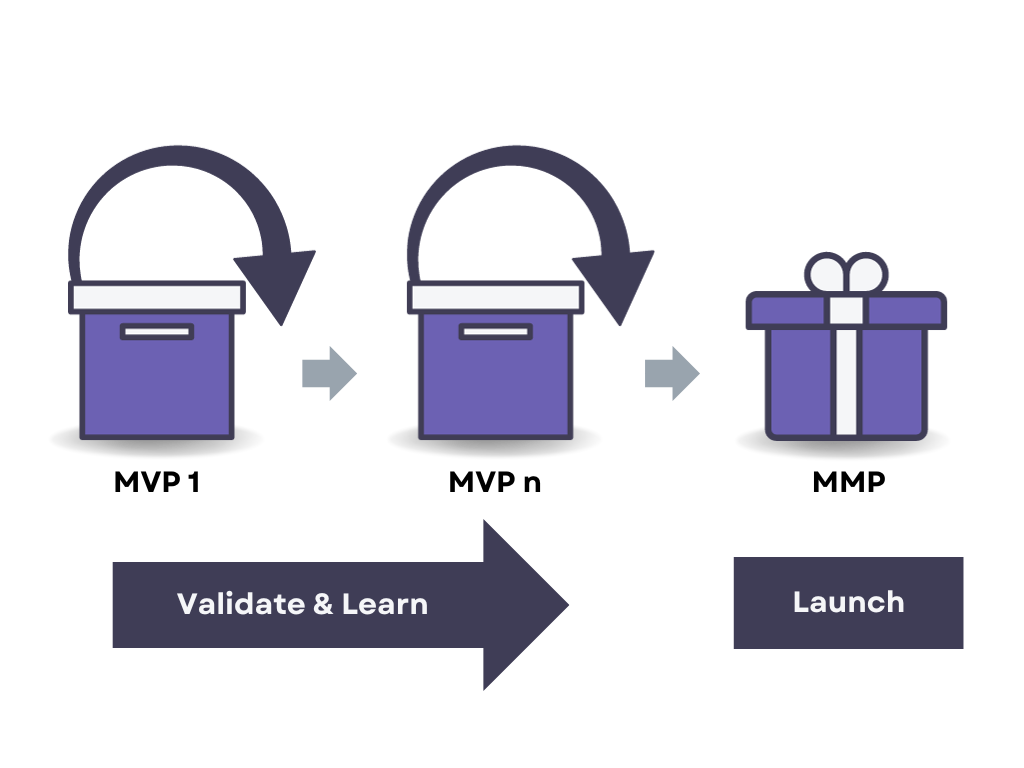From Viable to Marketable: What comes after an MVP?
Take your product to new heights!
In the world of startups and product development, an MVP is the launchpad for bringing your idea to life.
It’s a strategic approach that prioritises minimalism over perfection. In an MVP, speed and user feedback are what matters the most so you can test your assumptions and validate your idea.
The MVP is just the beginning of a long journey. So, if you've launched your MVP and are now wondering "What's next?" – you're in the right place.
Let’s go through how to measure MVP success, understand when and why scaling is necessary, and what comes after an MVP - behold the MMP (Minimum Marketable Product) ✨
Table of Contents
- How to measure MVP success?
- What comes after an MVP?
- How do you scale an MVP?
- Minimum Marketable Product (MMP)
- How do you build an MMP?
- Real-world example: Dropbox
- Key Takeaways
How to measure MVP success?
The MVP serves as a way to test the waters and see if your idea has merit. But how do you know if your MVP is actually successful?
By launching an MVP you should be able to:
- Validate: Test your assumptions about how well you know your target audience, how well your idea resonates and whether it solves a real problem. It's a reality check to help you determine whether your product is worth developing further.
- Learn: Collect enough real-world data and feedback from early adopters to inform future iterations. You need actionable insights into how users might use your product, features that your final product must have, how viable your business model is, market size, etc. These insights are invaluable for refining your product and making it more user-centric.
- Iterate: An important part of the MVP stage is to keep moving. Your first MVP probably won’t be just right. But you need to take the learnings and release the next iteration so you can keep learning and making your product better over time.
How you validate and learn from your MVP will be unique to your product and the market. Tracking metrics and KPIs that you would have ideally identified before launching can help you gauge the level of interest and demand your MVP is generating.
Some of the most popular metrics are the so-called ‘pirate metrics’ or AARRR (Acquisition, Activation, Retention, Referral, Revenue). It’s also important to choose metrics that matter to you rather than tracking everything. Choose a select few but meaningful and avoid vanity metrics.
For example, if you're developing a mobile app, you might track the number of downloads, daily active users, and time spent on the app.
On the other hand, if you’re building a SaaS, Monthly Recurring Revenue (MRR), Customer Lifetime Value (CLV) and Customer Acquisition Cost (CAC) would be more important.
Metrics alone don’t always tell the whole story. Another way to determine if your MVP is on the right track is to talk to your customers directly. This can be done through surveys, interviews or email.
Are customers giving you positive feedback? Are people finding your product easy to use and intuitive? Are they excited about your product? Are they happy to recommend it to others?
Are they coming back for more? What improvements are they suggesting? Are you solving a real problem or need in their lives? People might like your product, but do they like it enough to pay for it?
These are the types of questions you should be asking when measuring MVP success.
What comes after an MVP?
After you launch an MVP, you should track your set metrics and KPIs consistently and monitor user feedback closely. Then you can determine when and whether it’s worth moving to the next step.
In some cases, the MVP might not be as successful as you hoped for. The MVP isn’t supposed to be a perfect solution and in most cases, there will be a lot to improve. But if it fails to generate demand or solve a real problem, you might need to step back and start over.
Maybe the product didn’t resonate with your target audience or there were technical or usability issues. Even in this case, remember that the MVP did its job.
The MVP can either prove your idea is feasible or provide valuable feedback on why it’s not so you can learn and improve. So as next steps take the data and feedback you gathered to pinpoint the specific issues with your MVP.
Did it not solve the users' pain points? Did you not reach your target audience effectively? Was there a flaw in your product's usability or functionality?
Did you do enough market research? Were you targeting the right audience? Did you effectively communicate your unique selling point?
These are just a few questions you can ask yourself to understand better where things went wrong.
It might also be worth reflecting on your value proposition and messaging. Does it still align with the market's needs and preferences? Sometimes, a minor adjustment in features, pricing, or marketing strategy can make a significant difference.
On the other hand, if people are interested in your product and willing to pay for it, this indicates that your MVP has the potential for scaling.
How do you scale an MVP?
Launching your MVP is only the beginning. After that, you should continuously iterate without losing sight of your MVP’s core value proposition.
Based on user feedback, prioritise which features to build next. You might want to create an MVP with Minimum Viable Features (MVF). An MVF is a small-scale feature that can be quickly built and released so you can test and validate. This way you can identify what provides the most value to your users without building a fully-fledged feature.
You should also take into account your growing user base as your product gains traction. The more users come on board, the better your product should be able to handle the increased load to avoid downtimes.
Scalability is an important factor to consider as you plan and build your MVP. If your initial architecture isn't designed for scalability, it may be necessary to re-evaluate and introduce any necessary changes. It’s a good idea to use cloud-based services like AWS, Azure, or Google Cloud so you can easily scale up or down as needed.
As you grow, you may also need to extend your team to handle the increased workload.
Minimum Marketable Product (MMP)
After an MVP, the next stage in product development is often referred to as an MMP (Minimum Marketable Product). The MMP is a version of your product that has evolved beyond the bare minimum functionality of an MVP and is ready to be released and sold to the public.
Similar to the MVP, an MMP includes the absolute must-have features, but it goes a step further by adding some extra features that might have initially been considered but excluded from the MVP.
Which features to add should be informed by user feedback, market research and data you’ve collected during the MVP stage. Don’t add ‘extras’ just for the sake of it. Prioritise features that users actually want.
The goal is to have enough value and functionality to appeal to a broader audience and generate revenue, but still prioritise simplicity and time-to-market.
MVP vs MMP
While both an MVP and MMP focus on launching as quickly as possible with minimal resources, they have completely different goals.
An MVP is meant to be the stripped-down but working version of a product that can be released to test with selected users and validate your assumptions. While an MMP is a more developed (yet still basic) version with just enough features to be released and sold on the market.
In short, the MVP is the bare minimum required to test your idea, while an MMP is the minimal version required to cater to users and compete in the market.
Sometimes the lines between an MVP and MMP can be blurred. In some cases, developers can create an MVP that has a single or minimal set of features that provide enough value to be marketed and sold.
| MVP | MMP | |
|---|---|---|
| Goal | Validate, test and learn about a concept / idea | Launch a market-ready product |
| Scope | Minimal features for validation and testing | Improved features and user experience |
| Users | Early adopters, beta testers, investors | Reach a broader audience |
| Launch | Low-profile or beta launch | Strategic go-to-market plan |
How do you build an MMP?
So now that you know all about the MMP and how it’s different from an MVP, how do you make that transition? How do you take your MVP to the next level and make it ready for the market?
1. Analyse MVP feedback
It all comes down to how good the data you’ve gathered is during your MVP launch. This will serve as a stepping stone to uncover user needs, pain points and areas for improvement that you need to address in the MMP.
2. Prioritise new features
After having analysed user feedback, make a note of all features that your product needs to serve your users better. You won’t be able to include all features and you don’t want to do that to avoid over-engineering.
Instead, assign priority scores and arrange your product backlog by considering which features bring the most value to your users and address key needs and pain points. These are your must-have features.
Make sure you also consider how quickly each feature can be developed, tested and rolled out to make a final decision. Think ‘high-impact, low-effort'.
3. Polish the product
While design work isn’t as important in the MVP, it becomes a priority during the MMP. The product must be polished to ensure it’s easy to use, intuitive and provides a positive user experience.
The interface should also be visually appealing, in line with your branding and user expectations. You want to ship a product that can compete on the market. Sometimes user experience can be the deciding factor between two very similar solutions.
4. Test, test and test again
It’s important to invest in a robust quality assurance process to make sure that any new features work as expected. You can begin to develop features in small increments, testing each one with users as you go.
Consider implementing safeguards and automated tests at every turn so issues get flagged before they make it to production. You wouldn’t want to release a buggy product that might put off your customers.
5. Don’t stop collecting feedback
User feedback remains one of the most valuable metrics you should monitor. The MMP is not your final product. It serves to inform future iterations so you can continue shaping your product in the right direction.

Real-world example: Dropbox
Dropbox was founded in 2007 by Drew Houston. The idea was born after he had forgotten his USB drive and was unable to get any work done. So he identified a need and started working on a solution to help users easily store and share files online.
The problem was, however, that the market was overcrowded with similar products that didn’t work seamlessly which caused a lack of trust from investors and customers.
But Dropbox was able to solve a basic problem of file sharing and storage, which most users needed. They just didn’t know it yet.
So to avoid the risk of spending too much time and money building a product that nobody wants, Drew created a video which explained and showed how the product works. In this case, this served as an MVP with a simple landing page to capture leads.
The team received thousands of signups in one day after the video dropped, which proved that the idea had potential and people wanted to get their hands on the product.
The team at Dropbox focused all their time and effort into making a simple, yet neat product that worked like a charm and left users feeling happy and satisfied. Dropbox launched for the public in 2008.
This simplicity and ease of use was a major selling point, as other cloud storage solutions at the time were more complicated. The early version of Dropbox didn’t have lots of features, but it offered a simple solution to a problem that just worked right.
The team focused on achieving product-market fit and building a loyal customer base that spread the word like wildfire. They also introduced a very successful referral program that offered free extra storage to existing users who referred someone and new users who signed up.
The simple yet functional version of Dropbox led to its success and helped turn the product into a cloud storage service used by millions of users and businesses worldwide.
How the team at Dropbox decides what to build next:
- They prioritise usability, speed and reliability
- They track user requests
- They launch when “it’s done”
- “Do less” ≠ “half-assed”
Reference: Tech Crunch
Key Takeaways
We explored key aspects of measuring MVP success, what comes after an MVP, scaling strategies, and the concept of MMP.
The MVP is all about validating assumptions, learning from user feedback, and making informed decisions for future iterations.
An MMP is designed to be market-ready, competitive, and start generating revenue. Compared to an MVP, the MMP has improved functionality, refined user experience, and targeted marketing efforts to attract a broad customer base.
An MMP is about taking the lessons learned from the MVP stage and building a product that's not just functional but ready to thrive in the market.
You should give more thought to the user experience that your product offers, making sure it’s user-friendly, intuitive and doesn’t leave users confused. A carefully planned go-to-market strategy is also essential to make sure your product reaches the right people.
Product development is an iterative process so you should have the proper mechanisms to continuously gather feedback, swiftly adapt to market and user needs, and maintain a user-centric approach to building your product.




